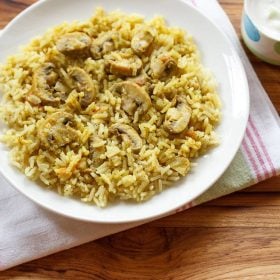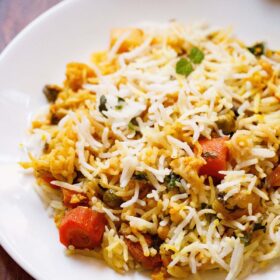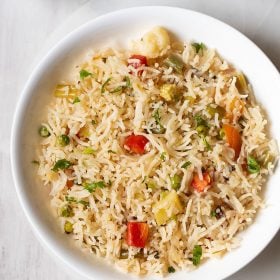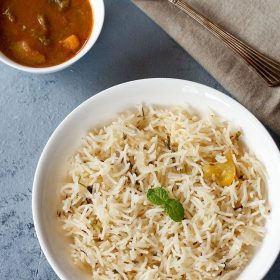Kuska Rice also known as Kuska, Khusqa or Khushka, is a simple South Indian way of making a flavorful dish, made with basmati rice, ghee and choicest of fragrant spices. Thus, it is also called as a Kuska Biryani minus vegetables and/or meats, as finally you have a rice-based dish which is super high both on flavors and fragrance. Traditionally, this taste laden rice dish is accompanied with a korma or Kurma, curry or gravy.

What is Kuska Rice
Since the one-pot Kuska Biryani from South India does not use any meat or veggies in its preparations, it is also sometimes referred to as ‘empty biryani’ or ‘MT Biryani‘.
It is also called ‘plain biryani‘. Interesting, isn’t it? Preferably, good quality basmati rice is a paramount requirement to make this rice.
Next, is the list of spices that play an integral role in giving the Kuska Rice its true essence. These are cinnamon, green cardamom, caraway seeds (shahi jeera), cloves, tej patta (Indian bay leaf), mace, etc.
However, the spice list is not just limited to this. Along with these, there’s onions, ginger, green chillies, coriander leaves, mint leaves and the likes.
In some restaurants you will find that in-spite of using a varied range of spices, herbs and seasonings, the white color of the rice is retained in the final preparation. One more reason that adds to the simplicity of this dish, yet being massive on flavors.
About Kuska Recipe
Kuska Rice is served in many restaurants and hotels in South India. The restaurants there, pair it with a side gravy preparation called Salna.
Kuska Biryani is a good alternative to the good old plain steamed rice, and can be had with gravies like a kurma, spiced robust curries, raitas and even with lentils or dal.
Kuska recipe can be made in different ways. In terms of the rice, if you don’t have basmati rice and have the finest quality seeraga samba rice which is a short grain rice variety, feel free to use it without any doubt.
The word ‘kuska’ has its origin in ‘khushk,’ which is an Urdu word meaning ‘dry.’ Hence, this is also a dry biryani preparation which does not have any vegetable masala or gravy in it.
There is no layering as well in this particular biryani. However, like a classic Biryani, this rice in this biryani is also dum cooked in a pot or pan.
As I said earlier, Kuska Rice is quite an easy way of making a flavorful rice dish. Just like Ghee Rice or even a basic Pulao, there’s not much that you have to do in terms of making this special rice from southern India.
Another variation to the Kuska Biryani is this Biryani Rice, which is more of a North Indian style of making it.
In addition to serving the Kuska Biryani with a korma gravy, masala gravy, salan, biryani shorba, dal, raita or just plain curd, I love to have it with rajma masala or even dal makhani. It tastes really good with these specialties as well.
How to make Kuska Rice
Prep Rice and Sauté Ingredients
1. Rinse 1 cup (215 grams) heaped basmati rice very well in water till the water runs clear of starch.
Soak rice in enough water for 20 to 30 minutes. I have used basmati rice. You can also use seeraga samba rice.
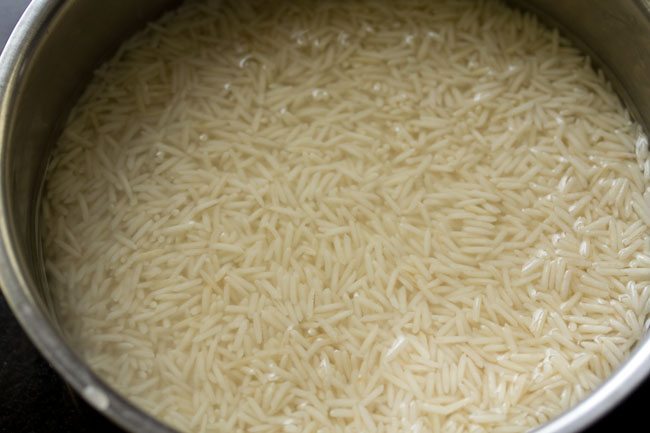
2. Heat 2 tablespoons ghee in a pot or pan.

3. Add the following listed spices and let them splutter on low heat:
- ½ teaspoon caraway seeds (shahi jeera) – swap with ½ teaspoon cumin seeds instead
- 1 inch cinnamon
- 2 to 3 cloves
- 2 green cardamoms
- 1 to 2 single strands of mace
- 1 tej patta (Indian bay leaf)
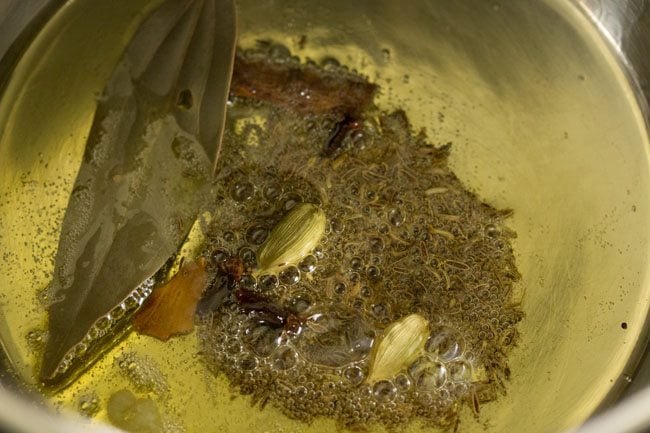
4. Then, add ⅓ cup thinly sliced onions.

5. Sauté the onions on low to medium heat, stirring often.
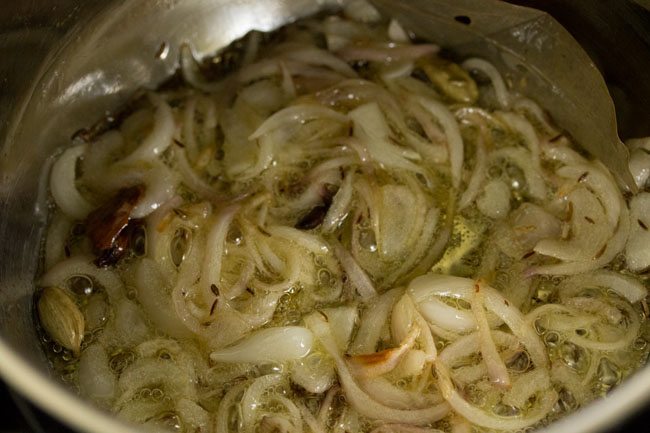
6. Sauté till the onions start turning light golden.

7. Then, add 1 teaspoon ginger-garlic paste.
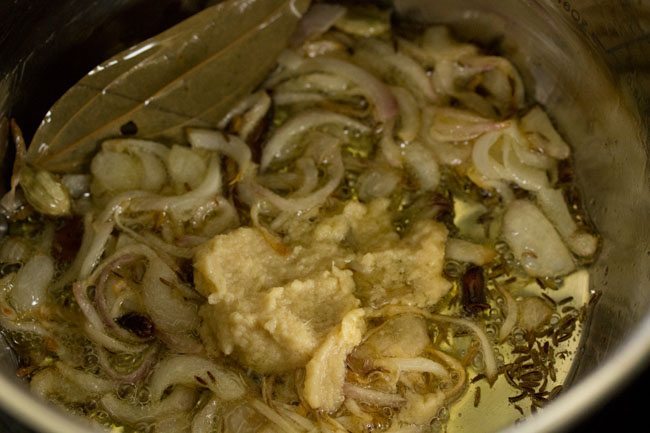
8. Stir and sauté on low heat for a few seconds till the raw aroma of ginger and garlic goes away.
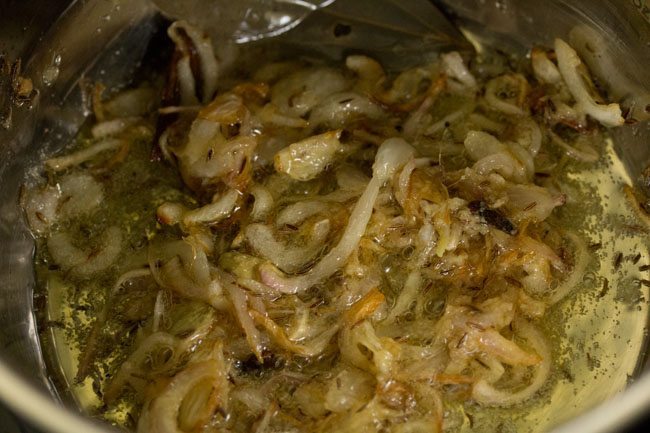
9. Add ½ cup chopped tomatoes and sauté for a minute. You can even skip tomatoes if you want.
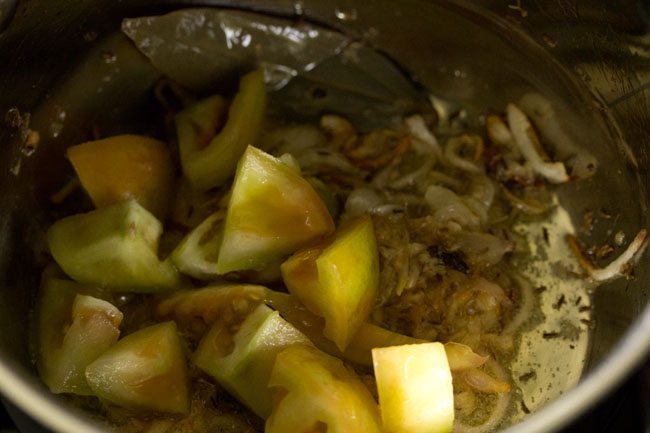
10. Add 1 or 2 sliced or slit green chilies, 1 tablespoon chopped mint leaves and 2 tablespoons chopped coriander leaves.
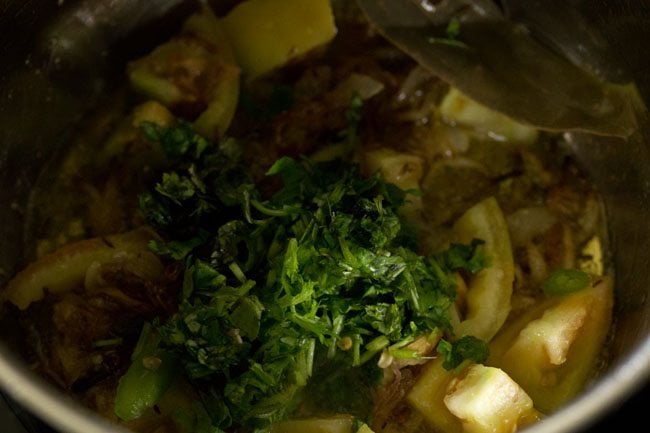
11. Mix very well.

12. Now, add 2 cups water. Instead of water, you can also use Vegetable Stock. Depending on the quality and type of rice, you can add 1.5 to 2.25 cups water.

Cook Kuska Rice
13. Cover the pan with its lid.

14. On medium heat, bring the entire water mixture to a boil.
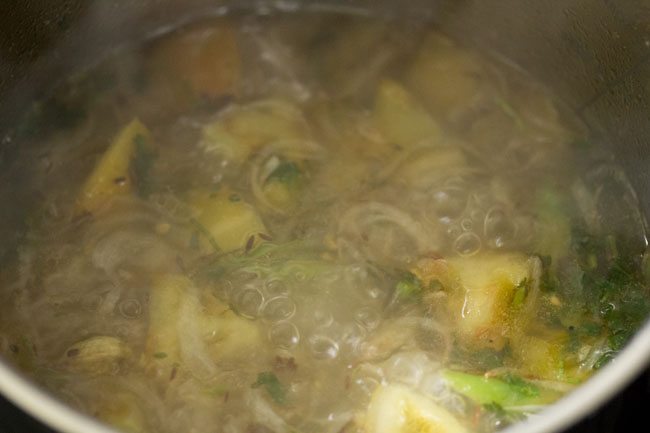
15. When the water starts boiling, remove the lid and then add the rice.

16. Season with salt as per taste and mix very well. Taste the water, it should taste a bit salty. If not, then add some more salt.
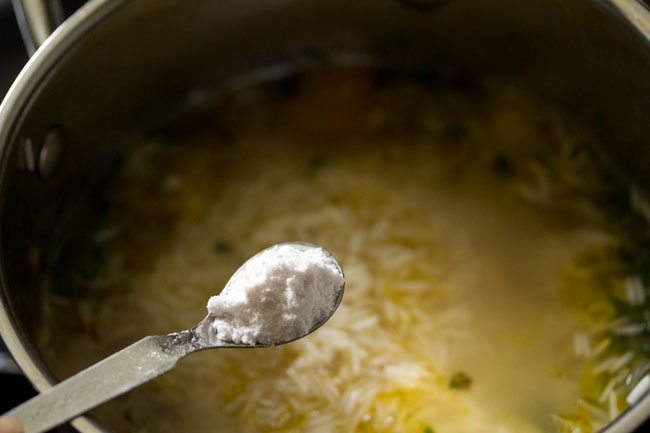
17. Add 1 teaspoon lemon juice. Stir once again.
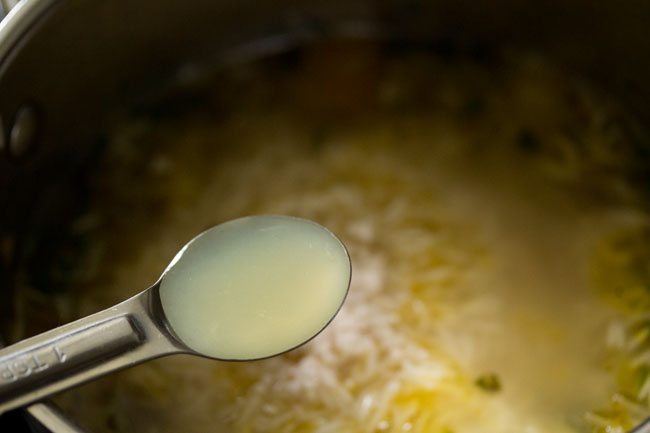
18. Place a cotton kitchen towel or napkin on the pan. You can also seal the pan with an aluminum foil. Now, place the lid on the pan.

19. Keep the heat to low or sim and dum cook till the rice grains are tender and cooked. It will take about 7 to 8 minutes for the rice to cook and soften.
Do use a thick bottomed pan, so that the rice grains do not stick at the bottom of the pan. If you want you can check the rice grains once while cooking.
If all the water has been absorbed and the rice grains do not look cooked, then add some hot water in the pan. Cover and continue to simmer.

20. When the rice grains are tender, soft and all the water has been absorbed, then turn off the heat and allow a resting time of 5 to 7 minutes.
Later, gently fluff the rice with a fork. Serve Kuska Rice garnished with 1 to 2 tablespoons of coriander or mint leaves paired with a veg gravy, korma, raita, curry or dal of your choice.
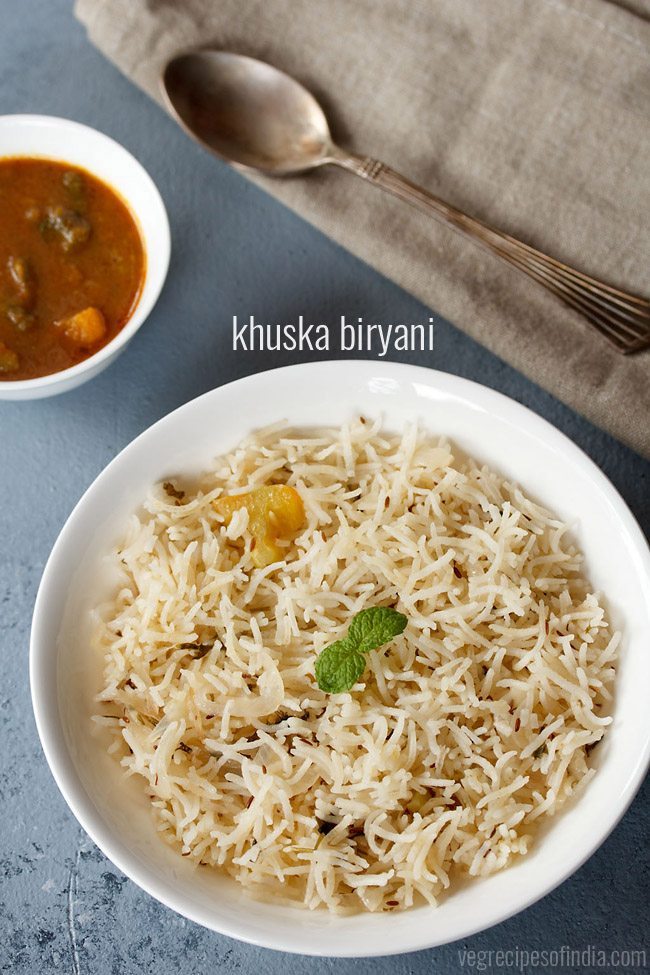
Expert Tips
- Long grained basmati rice works best for this recipe. However, as in Tamil Nadu and other South Indian states, short grain rice varieties like seeraga samba rice are also used. You can do that too.
- Depending on the type of rice, make sure to use a proper water to rice ratio so that you don’t end up getting overcooked or undercooked rice.
- Instead of water, you can use vegetable stock to cook the rice in this Kuska recipe.
- While ghee is what I prefer to cook this rice as it only adds to the flavors, you can also use oil. That way, the recipe also becomes a vegan dish.
- You can skip adding the tomatoes in the kuska recipe.
- If you don’t have shahi jeera or caraway seeds at home, use the regular jeera or cumin seeds.
- If you have homemade biryani masala or even a store-bought one, you can add that to this Kuska Rice as well. But I prefer mine without the use of it.
More Biryani Recipes To Try!
Rice Recipes
Tamil Nadu Food
Kerala Recipes
Uttar Pradesh Cuisine
Please be sure to rate the recipe in the recipe card or leave a comment below if you have made it. For more vegetarian inspirations, Sign Up for my emails or follow me on Instagram, Youtube, Facebook, Pinterest or Twitter.
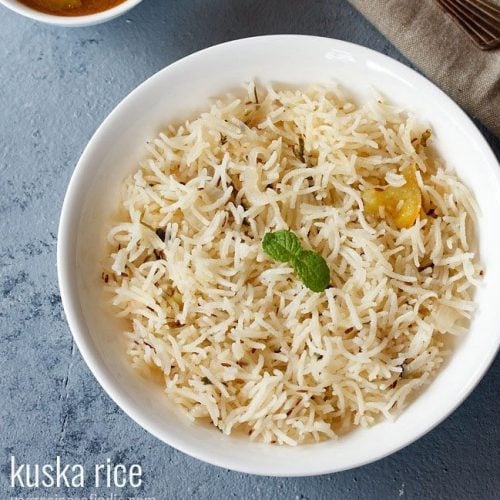
Kuska Rice | Kuska Biryani | Kuska Recipe
Ingredients
main ingredients
- 1 cup heaped basmati rice – 215 grams
- 2 tablespoons Ghee
- 50 grams onions or 1 medium onion or ⅓ cup thinly sliced onions
- 65 grams tomatoes or 1 medium to large tomato or ½ cup chopped tomatoes
- 1 teaspoon Ginger Garlic Paste
- 1 or 2 green chilies – sliced or slit
- 1 tablespoon mint leaves – chopped
- 2 tablespoons coriander leaves – chopped
- 2 cups water or 2.25 cups water
- 1 teaspoon lemon juice
- salt as required
- 1 to 2 tablespoons coriander leaves or mint leaves for garnish
Whole spices
- ½ teaspoon caraway seeds – shahi jeera or add ½ teaspoon cumin seeds instead
- 1 inch cinnamon
- 2 to 3 cloves
- 2 green cardamoms
- 1 to 2 single, thin strands of mace
- 1 tej patta (Indian bay leaf)
Instructions
Soaking rice
- Rinse basmati rice very well in water till the water runs clear of starch.
- Soak rice in enough water for 20 to 30 minutes. Later drain all the water and keep the rice aside.
Making kuska rice
- Heat 2 tablespoons ghee in a pot or pan. Keep heat to a low.
- Add the following spices and let them splutter – caraway seeds, cinnamon, cloves, green cardamoms, single strands of mace and tej patta.
- Then add thinly sliced onions.
- Sauté the onions on a low to medium heat stirring often, till they start turning light golden.
- Then add ginger-garlic paste.
- Stir and sauté on a low heat for a few seconds till the raw aroma of ginger and garlic goes away.
- Add chopped tomatoes and sauté for a minute. You can even skip tomatoes if you prefer.
- Then add the sliced or slit green chilies, chopped mint leaves and coriander leaves. Mix very well.
- Now add 2 cups water. Instead of water you can also use vegetable stock. Depending on the quality and variety of rice, you can add 1.5 to 2.25 cups water.
Cooking kuska biryani
- Cover the pan with its lid.
- On a medium heat, bring the entire water mixture to a boil.
- When the water starts boiling, remove the lid, and then add the rice.
- Season with salt as per taste and mix very well. Check the taste of the water and it should taste a bit salty. If not, then add some more salt.
- Add lemon juice. Again stir.
- Place a cotton kitchen towel or cotton napkin on the pan. You can also seal the pan with an aluminium foil. Now place the lid on the pan.
- Keep the heat to a low or sim and dum cook till the rice grains are tender and cooked. It will take about 7 to 8 minutes for the rice to cook.
- Do use a thick bottomed pan, so that the rice grains do not stick to the bottom of the pan.
- If you want you can check the rice grains once while cooking. If all the water has been absorbed and the rice grains do not look cooked, then add some hot water in the pan. Cover and continue to cook.
- When the rice grains are soft and tender, turn off heat. Then allow resting time of 5 to 7 minutes. Later gently fluff the rice with a fork.
- Serve Kuska Rice garnished with coriander or mint leaves paired with with a veg gravy or dal of your choice.
Notes
- You can also use seeraga samba rice instead of basmati rice.
- If you do not soak the rice, then add some more water while cooking.
- For a vegan version, use any neutral flavored oil instead of ghee.
- I do not add any ground spices like turmeric powder or red chilli powder as the color of the dish no longer remains white or off-white. But feel free to spice up the kuska rice a bit, by adding your choice of ground spices.
- The recipe can be halved or doubled according to your needs.
Nutrition Info (Approximate Values)
This Kuska Rice from the archives, originally published in October 2016 has been updated and republished on January 2023.
